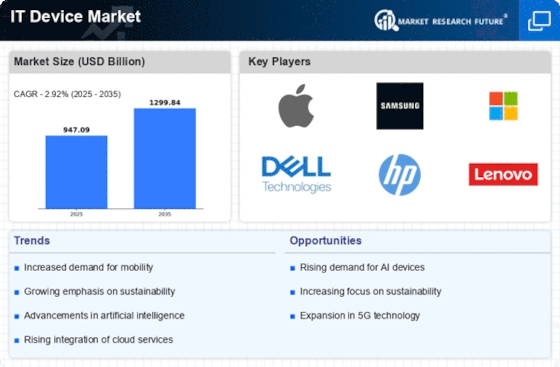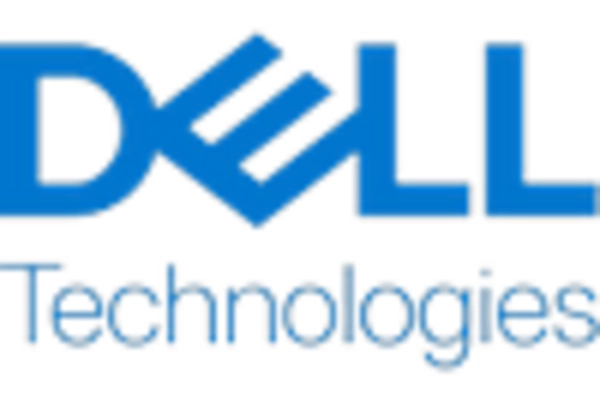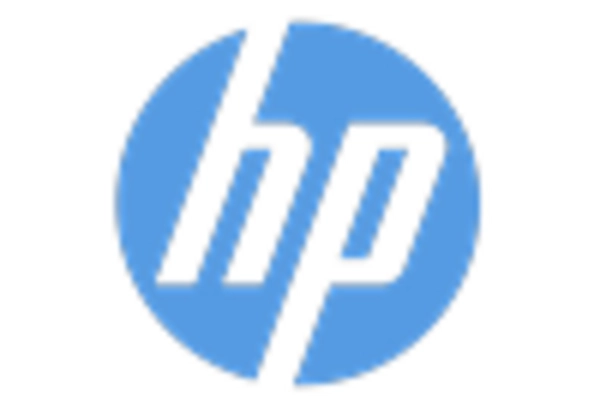Emergence of 5G Technology
The rollout of 5G technology is poised to transform the IT Device Market by enabling faster and more reliable connectivity. With the potential to enhance mobile broadband experiences, 5G is expected to drive demand for devices that can leverage its capabilities. Analysts predict that by 2026, the number of 5G connections could reach over 1.5 billion, indicating a substantial market opportunity for manufacturers. This technological advancement encourages the development of new devices, such as smartphones and IoT gadgets, that can fully utilize 5G networks. As a result, the IT Device Market is likely to witness a wave of innovation, with companies racing to introduce devices that offer superior performance and connectivity options.
Advancements in Cloud Computing
The IT Device Market is significantly influenced by advancements in cloud computing technologies. As businesses increasingly migrate their operations to the cloud, the demand for devices that can seamlessly integrate with cloud services is on the rise. This shift has led to a growing preference for lightweight devices that offer robust cloud capabilities. Recent statistics indicate that cloud adoption rates have reached over 80 percent among enterprises, driving the need for compatible IT devices. Consequently, manufacturers are focusing on developing devices that not only support cloud applications but also enhance user experience through improved processing power and storage options. This trend suggests a promising future for the IT Device Market as it aligns with the evolving technological landscape.
Growing Focus on Sustainability
Sustainability has emerged as a critical driver within the IT Device Market, as consumers and businesses alike prioritize eco-friendly products. The increasing awareness of environmental issues has prompted manufacturers to adopt sustainable practices in their production processes. Recent surveys indicate that over 70 percent of consumers are willing to pay a premium for devices made from recycled materials or those that are energy-efficient. This trend is influencing product design and marketing strategies, as companies strive to meet the expectations of environmentally conscious consumers. The IT Device Market is likely to see a rise in the availability of sustainable devices, which could reshape purchasing decisions and brand loyalty in the coming years.
Integration of Advanced Security Features
The IT Device Market is witnessing a heightened emphasis on security features as cyber threats become increasingly sophisticated. Organizations are investing in devices equipped with advanced security measures to protect sensitive data and maintain compliance with regulations. Recent reports suggest that The IT Device is projected to reach over 300 billion by 2024, underscoring the importance of security in the IT Device Market. Manufacturers are responding by incorporating biometric authentication, encryption technologies, and secure boot processes into their devices. This focus on security not only enhances user trust but also drives innovation within the industry, as companies seek to differentiate their products in a competitive landscape.
Increased Demand for Remote Work Solutions
The IT Device Market experiences a notable surge in demand for devices that facilitate remote work. As organizations continue to embrace flexible work arrangements, the need for laptops, tablets, and other portable devices has escalated. According to recent data, the sales of laptops have increased by approximately 15 percent in the last year, reflecting a shift in consumer preferences towards mobile computing solutions. This trend is likely to persist as companies invest in technology that supports remote collaboration and productivity. Furthermore, the IT Device Market is adapting to this demand by introducing devices with enhanced battery life and connectivity features, ensuring that remote workers have the tools necessary to perform efficiently from various locations.


















Leave a Comment